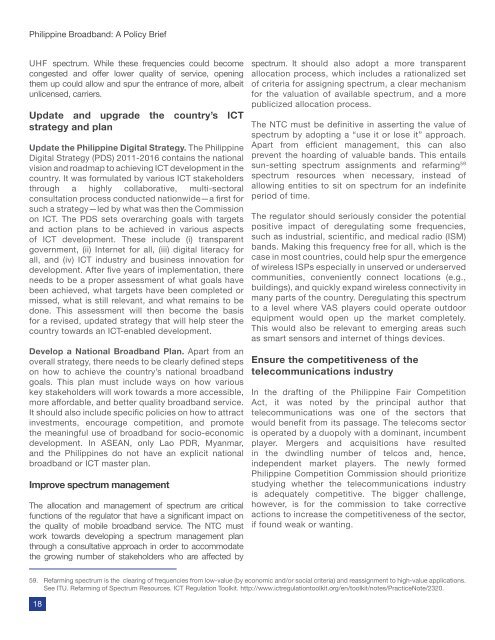Philippine Broadband A Policy Brief
ONLINE-BROADBAND-POLICY-BRIEF1
ONLINE-BROADBAND-POLICY-BRIEF1
Create successful ePaper yourself
Turn your PDF publications into a flip-book with our unique Google optimized e-Paper software.
<strong>Philippine</strong> <strong>Broadband</strong>: A <strong>Policy</strong> <strong>Brief</strong><br />
UHF spectrum. While these frequencies could become<br />
congested and offer lower quality of service, opening<br />
them up could allow and spur the entrance of more, albeit<br />
unlicensed, carriers.<br />
Update and upgrade the country’s ICT<br />
strategy and plan<br />
Update the <strong>Philippine</strong> Digital Strategy. The <strong>Philippine</strong><br />
Digital Strategy (PDS) 2011-2016 contains the national<br />
vision and roadmap to achieving ICT development in the<br />
country. It was formulated by various ICT stakeholders<br />
through a highly collaborative, multi-sectoral<br />
consultation process conducted nationwide—a first for<br />
such a strategy—led by what was then the Commission<br />
on ICT. The PDS sets overarching goals with targets<br />
and action plans to be achieved in various aspects<br />
of ICT development. These include (i) transparent<br />
government, (ii) Internet for all, (iii) digital literacy for<br />
all, and (iv) ICT industry and business innovation for<br />
development. After five years of implementation, there<br />
needs to be a proper assessment of what goals have<br />
been achieved, what targets have been completed or<br />
missed, what is still relevant, and what remains to be<br />
done. This assessment will then become the basis<br />
for a revised, updated strategy that will help steer the<br />
country towards an ICT-enabled development.<br />
Develop a National <strong>Broadband</strong> Plan. Apart from an<br />
overall strategy, there needs to be clearly defined steps<br />
on how to achieve the country’s national broadband<br />
goals. This plan must include ways on how various<br />
key stakeholders will work towards a more accessible,<br />
more affordable, and better quality broadband service.<br />
It should also include specific policies on how to attract<br />
investments, encourage competition, and promote<br />
the meaningful use of broadband for socio-economic<br />
development. In ASEAN, only Lao PDR, Myanmar,<br />
and the <strong>Philippine</strong>s do not have an explicit national<br />
broadband or ICT master plan.<br />
Improve spectrum management<br />
The allocation and management of spectrum are critical<br />
functions of the regulator that have a significant impact on<br />
the quality of mobile broadband service. The NTC must<br />
work towards developing a spectrum management plan<br />
through a consultative approach in order to accommodate<br />
the growing number of stakeholders who are affected by<br />
spectrum. It should also adopt a more transparent<br />
allocation process, which includes a rationalized set<br />
of criteria for assigning spectrum, a clear mechanism<br />
for the valuation of available spectrum, and a more<br />
publicized allocation process.<br />
The NTC must be definitive in asserting the value of<br />
spectrum by adopting a “use it or lose it” approach.<br />
Apart from efficient management, this can also<br />
prevent the hoarding of valuable bands. This entails<br />
sun-setting spectrum assignments and refarming 59<br />
spectrum resources when necessary, instead of<br />
allowing entities to sit on spectrum for an indefinite<br />
period of time.<br />
The regulator should seriously consider the potential<br />
positive impact of deregulating some frequencies,<br />
such as industrial, scientific, and medical radio (ISM)<br />
bands. Making this frequency free for all, which is the<br />
case in most countries, could help spur the emergence<br />
of wireless ISPs especially in unserved or underserved<br />
communities, conveniently connect locations (e.g.,<br />
buildings), and quickly expand wireless connectivity in<br />
many parts of the country. Deregulating this spectrum<br />
to a level where VAS players could operate outdoor<br />
equipment would open up the market completely.<br />
This would also be relevant to emerging areas such<br />
as smart sensors and internet of things devices.<br />
Ensure the competitiveness of the<br />
telecommunications industry<br />
In the drafting of the <strong>Philippine</strong> Fair Competition<br />
Act, it was noted by the principal author that<br />
telecommunications was one of the sectors that<br />
would benefit from its passage. The telecoms sector<br />
is operated by a duopoly with a dominant, incumbent<br />
player. Mergers and acquisitions have resulted<br />
in the dwindling number of telcos and, hence,<br />
independent market players. The newly formed<br />
<strong>Philippine</strong> Competition Commission should prioritize<br />
studying whether the telecommunications industry<br />
is adequately competitive. The bigger challenge,<br />
however, is for the commission to take corrective<br />
actions to increase the competitiveness of the sector,<br />
if found weak or wanting.<br />
59. Refarming spectrum is the clearing of frequencies from low-value (by economic and/or social criteria) and reassignment to high-value applications.<br />
See ITU. Refarming of Spectrum Resources. ICT Regulation Toolkit. http://www.ictregulationtoolkit.org/en/toolkit/notes/PracticeNote/2320.<br />
18


